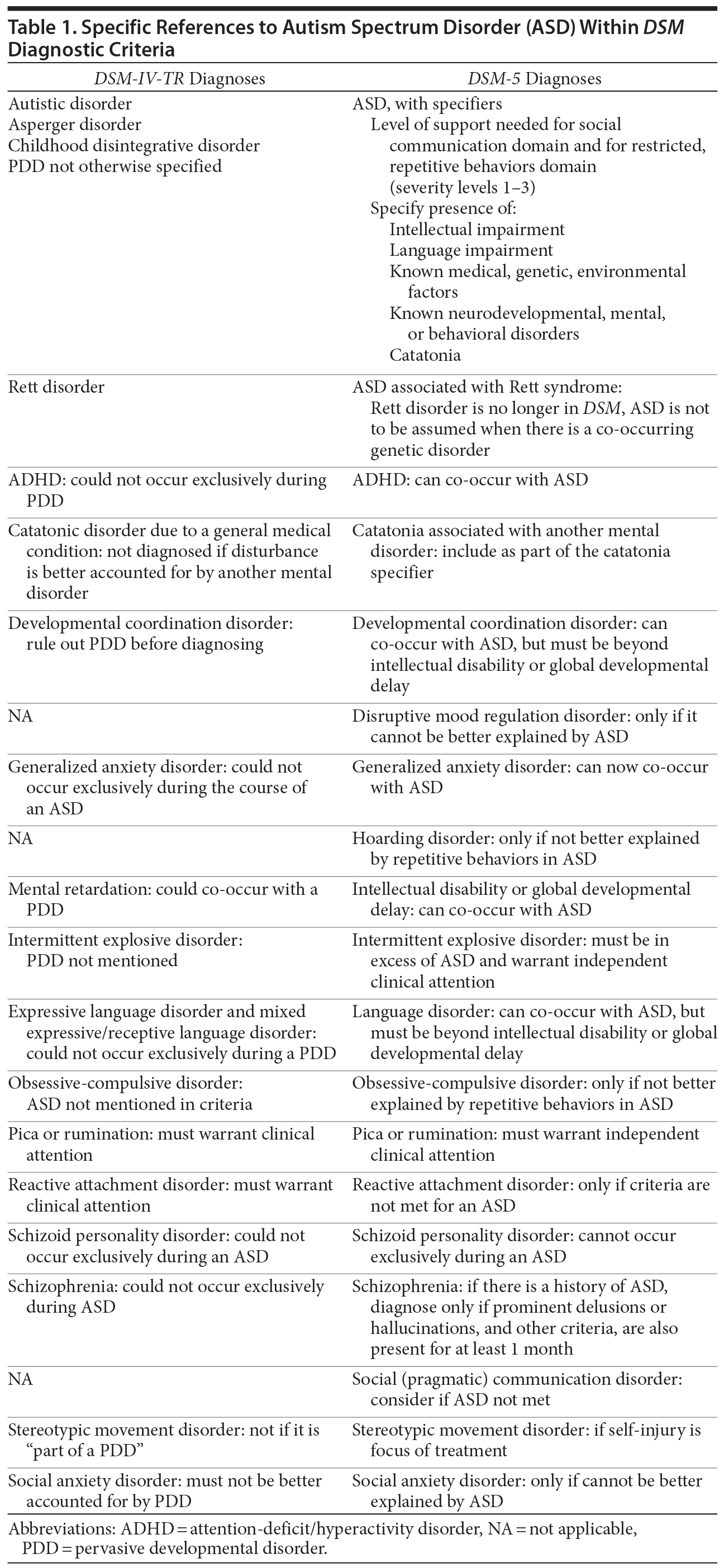DSM-5 and Autism Spectrum Disorders: The Changes You Haven’ t Heard About Yet
To the Editor: Much attention has been drawn to the changes within autism spectrum disorder (ASD) criteria in DSM-5. However, in considering the ASD revisions, the changes to diagnoses throughout DSM-5 also warrant discussion, because they give clinicians new tools for diagnosing the co-occurring conditions often seen in ASD. These revisions may fundamentally change how we conceptualize ASD, because we will be better able to identify co-occurring conditions for research, clinical care, and even insurance coverage. When a patient’s presentation is viewed only through the lens of ASD, we run the risk of diagnostic overshadowing or the misattribution of physical or emotional symptoms to the developmental disorder.1 Such failure to recognize co-occurring symptoms as separate conditions can restrict the types of interventions made available to patients. Furthermore, when co-occurring conditions are not well accounted for in research studies, our ability to detect signal from noise is hampered. The changes in DSM-5 are an important step in reducing this risk in ASD.
Table 1 lists the disorders in DSM-IV-TR and DSM-5 that specifically name ASD within the criteria, either for differential diagnosis or for guidance about co-occurring diagnoses. Of course, disorders not listed in the table can, and do, co-occur with ASD, especially in the areas of anxiety, mood, learning, sleep, elimination, and food intake.
Much more research is needed to determine how ASD may affect the presentation of co-occurring disorders, especially those with behavioral overlap. In some cases, the 2 conditions can be easily recognized, such as in the individual with ASD who articulates social anxiety and fear of negative appraisal (ASD and social anxiety) or the individual with ASD who describes intrusive thoughts about germs and compulsive hand-washing (ASD and obsessive-compulsive disorder [OCD]). However, in other cases, ASD may color the presentation of the co-occurring disorder, such as the individual with ASD who cannot articulate social anxiety, but who is visibly distressed in social situations with unfamiliar children (ASD and possible social anxiety). Or the individual with ASD who repetitively sorts or lines up toys "just so" in pursuit of a circumscribed interest rather than to reduce unwanted intrusive thoughts (ASD rather than OCD). DSM-5 acknowledges that some diagnoses should not be made if the impairments "are better explained by"2(pp156,203) ASD, but these distinctions can be difficult to make, especially for clinicians less familiar with ASD.
DSM-5 wording for 3 disorders (attention-deficit/hyperactivity disorder, language disorders, developmental coordination disorder) was changed to facilitate codiagnosis. These and many other impairments (eg, sleep, feeding, anxiety, pica, self-injury) are frequent targets for both pharmacologic and behavioral treatment. DSM-5 presents a new opportunity for documentation to more thoroughly reflect the targeting of these specific symptoms within an individualized treatment plan.
There are now very few disorders in DSM-5 that cannot be codiagnosed with ASD. Only 2 require ruling ASD out: reactive attachment disorder and the new social (pragmatic) communication disorder. Three other diagnoses (selective mutism, schizoid personality disorder, and schizotypal personality disorder) should be made only if symptoms "do not occur exclusively during the course of"2(pp195,653,656) ASD. Since ASD is not characterized by episodes in which symptoms are present, absent, and then present again, the "course" of ASD is generally lifelong. Therefore, any condition would, by default, occur during the "course" of ASD. For these conditions, then, it may be better to diagnose when the symptoms "are not better explained by"2(pp156,203) ASD and for DSM to provide more guidance on how to distinguish them. For example, all 3 involve a change in functioning (speaking to mute, ASD alone to ASD with a personality disorder).
By identifying co-occurring conditions accurately and completely, we can ensure that we are treating the whole individual with ASD and better study this heterogeneous group.
References
1. Reiss S, Levitan GW, Szyszko J. Emotional disturbance and mental retardation: diagnostic overshadowing. Am J Ment Defic. 1982;86(6):567-574. PubMed
2. American Psychiatric Association. Diagnostic and Statistical Manual of Mental Disorders, Fifth Edition. Arlington, VA: American Psychiatric Publishing; 2013.
Author affiliation: Center for Autism Research, Children’s Hospital of Philadelphia, University of Pennsylvania, Philadelphia.
Potential conflicts of interest: No additional potential conflict of interest reported.
Funding/support: Dr Miller is funded by Leadership Education in Neurodevelopmental Disorders (LEND; through HRSA T73MC00051-14) and Shire Pharmaceuticals.
Role of the sponsor: The funding organizations provided support for manuscript preparation.
Acknowledgments: The author thanks Benjamin E. Yerys, PhD (Center for Autism Research, Children’s Hospital of Philadelphia, University of Pennsylvania, Philadelphia); Ashley de Marchena, PhD (Center for Autism Research, Children’s Hospital of Philadelphia); and Emily Kuschner, PhD (Radiology, Center for Autism Research, Children’s Hospital of Philadelphia), for helpful comments on this letter. Dr Yerys is funded by National Institutes of Health (NIH R21MH092615 and K23MH086111). Dr Kuschner is funded by Autism Speaks, the Simons Foundation, and NIH (R01HD073258). Dr de Marchena is funded by NIH (R21MH098153).
J Clin Psychiatry 2014;75(11):e1326-e1327 (doi:10.4088/JCP.13l08933).
© Copyright 2014 Physicians Postgraduate Press, Inc.



